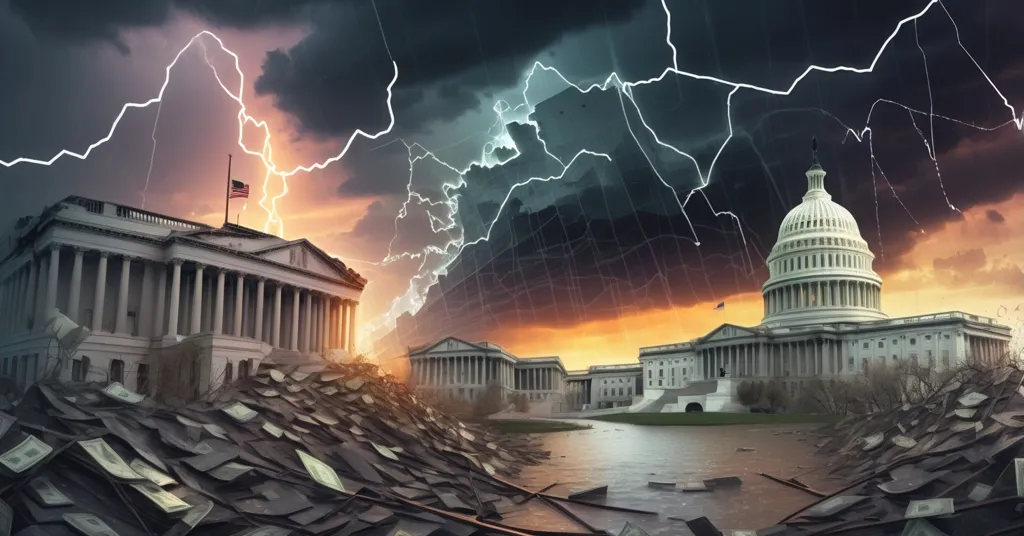Senate Deal to End Shutdown: Bitcoin and Crypto Markets Eye Recovery Amid Uncertainty

Senate Bipartisan Deal Emerges to End Shutdown: Bitcoin and Crypto Markets Brace for Impact
After a punishing 40-day U.S. government shutdown, Senate leaders have forged a bipartisan agreement that could finally restart federal operations and calm the economic turbulence rattling financial markets, including the unpredictable realm of Bitcoin and cryptocurrencies. With Bitcoin suffering a notable price drop amid the chaos, this deal might offer a much-needed spark—or at least a breather—for the crypto space.
- Shutdown Fallout: 40-day government closure halts services, impacts federal workers, and shakes crypto markets.
- Senate Breakthrough: Bipartisan budget plan passes procedural vote 60-40, aiming to fund government until January.
- Bitcoin Hit: Price declines significantly during prolonged uncertainty, reflecting investor caution.
Government Shutdown: A 40-Day Economic Freeze
The U.S. government has been shuttered for 40 days, a deadlock that’s left public services in disarray, federal employees without pay, and financial markets—both traditional and decentralized—reeling from the uncertainty. This isn’t just a political spat; it’s a slow-burn crisis that’s seeped into every corner of the economy. For the crypto community, the shutdown has been a stark reminder that even decentralized systems like Bitcoin, which operates on a tamper-proof blockchain—a digital ledger securing transactions without a central authority—aren’t fully insulated from the mess of centralized governance. Bitcoin’s price, often a barometer of market sentiment, peaked at an impressive level early in the shutdown but has since fallen sharply, with a decline of around 17% as the stalemate persisted. For newcomers, this volatility underscores how broader economic conditions, like political gridlock, can sway even the most independent of assets.
Bitcoin and Crypto Markets Feel the Burn
The shutdown’s impact on cryptocurrencies goes beyond just price swings. Regulatory progress, a critical driver of investor confidence, has ground to a screeching halt. Agencies like the Securities and Exchange Commission (SEC) and the Commodity Futures Trading Commission (CFTC) have been sidelined, delaying decisions on pivotal issues such as spot Bitcoin Exchange-Traded Funds (ETFs)—investment vehicles that could bring mainstream legitimacy to crypto—and oversight of digital asset derivatives. Without these frameworks, institutional players, think big names like BlackRock or Fidelity, are hesitating to dive into the market, leaving Bitcoin and altcoins (any cryptocurrency other than Bitcoin, often with unique use cases like Ethereum’s smart contract platform) vulnerable to sentiment-driven dips. On-chain data during this period has shown reduced trading volumes, a sign that even retail traders are holding back, wary of the next shoe to drop.
Altcoins haven’t escaped the pain either. Ethereum, which powers decentralized finance (DeFi) protocols and applications through its smart contracts, has seen its ecosystem strained as investors pull back from riskier assets. Layer-2 scaling solutions, designed to make Ethereum transactions faster and cheaper, are also feeling the pinch as funding and development slow amid uncertainty. While Bitcoin maximalists—those who see BTC as the ultimate digital gold—might argue this proves Bitcoin’s dominance, it’s hard to ignore that altcoin innovation often complements Bitcoin’s adoption by filling niches like programmable money or decentralized apps that BTC wasn’t designed for.
Bipartisan Deal: Light at the End of the Tunnel?
Amid the gloom, a flicker of hope has emerged from Capitol Hill. Senate leaders, spearheaded by Republican Majority Leader John Thune after 15 grueling attempts at compromise, have secured a bipartisan agreement to end the shutdown. The budget plan, which passed a procedural vote with a solid 60-40 margin, will fund the government until the end of January. A final Senate vote is expected any day now, with the House poised to follow suit for full approval. Beyond just reopening federal doors, the deal paves the way for December votes on extending tax credits under the Affordable Care Act and tackling the layoffs of federal workers—a move to stabilize thousands of households caught in the crossfire.
Yet, let’s not get ahead of ourselves. While the procedural vote is a step forward, there’s always a chance for last-minute snags, especially with the House’s unpredictable dynamics. If this deal holds, it could signal a return to normalcy—or at least a temporary one—that crypto markets desperately need. Regulatory wheels might start turning again, potentially unlocking institutional capital that’s been sitting idle. But if it falls apart, expect another wave of panic selling in an already jittery market.
External Pressures: Tariffs and Global Risks
As if a domestic shutdown wasn’t enough, global headwinds are piling on the pressure. President Donald Trump’s recent announcement of a staggering 100% tariff on China has sent shockwaves through international markets, making investors even more skittish about speculative assets like cryptocurrencies. For the crypto space, this isn’t just background noise—higher tariffs could drive up costs for mining hardware, much of which is manufactured in China, squeezing Bitcoin miners’ already thin margins. Trump’s additional proposal of a $2,000 dividend for Americans, funded by tariff revenue, might boost consumer spending, but its impact on crypto remains a wild card. Will everyday folks pour that cash into Bitcoin, or will they steer clear of volatile markets altogether?
These external factors highlight a bitter irony for decentralization advocates. Bitcoin was born from the ashes of the 2008 financial crisis to challenge centralized control, yet here we are, watching it sway under the weight of government policies and trade wars. For Bitcoin maximalists, this is a rallying cry to push harder for financial sovereignty. But even the most ardent believers must admit that market sentiment—and altcoin ecosystems—still play a role in BTC’s broader journey.
Historical Lessons and Future Outlook
History offers a dose of cautious optimism. During the 2018-2019 government shutdown, Bitcoin’s price sat at a modest $3,550 before soaring to $13,000 in the five months after federal operations resumed. It’s not a crystal ball, but it suggests that markets often shake off political dysfunction once stability returns. Blockchain-based prediction platforms like Polymarket, where users wager on real-world events using crypto, are also leaning toward a positive outcome. The probability of the government reopening between Tuesday and Friday has spiked from 27% to 54%, reflecting growing trader confidence. For those unfamiliar, prediction markets act like a decentralized opinion poll, often capturing collective sentiment with surprising accuracy, though they’re far from infallible.
Playing devil’s advocate for a moment, let’s not assume a post-shutdown recovery is guaranteed. House approval could hit roadblocks, or ongoing global tensions—like escalating trade disputes—might overshadow any domestic resolution. Bitcoin’s narrative as a hedge against centralized failure gets tested in moments like these. Is it truly independent, or still too tethered to traditional finance and political whims? And let’s be clear: don’t buy into the ridiculous $200,000 Bitcoin prophecies floating around social media tied to this deal. Market fundamentals—adoption, network security, and real-world utility—still call the shots, not hype-driven shilling.
If the Senate’s deal sticks, we might see pent-up institutional interest flood back into crypto, potentially reversing recent losses. Regulatory clarity, even the hint of it, often acts like a shot of adrenaline for market confidence. Bitcoin’s scarcity and battle-tested network security position it as the ultimate store of value in turbulent times, though Ethereum’s smart contract innovation continues to carve out a vital complementary role. But if global risks or political missteps persist, brace for more turbulence. As champions of decentralization, we’re rooting for blockchain tech to disrupt the status quo, but we’re not naive—politics still wields too much influence over this revolution.
Key Questions Answered
- How does a U.S. government shutdown impact Bitcoin and crypto markets?
It fuels economic uncertainty, stalls critical crypto regulations like Bitcoin ETF approvals, and drives investor caution, leading to significant price drops over the 40-day closure. - What’s the latest on the bipartisan deal to end the shutdown?
Senate leaders passed a procedural 60-40 vote on a budget plan to fund the government until January, with final Senate and House votes expected soon to restore operations. - Could Bitcoin recover after the shutdown, as seen in past crises?
Historical precedent suggests yes—Bitcoin surged from $3,550 to $13,000 within five months after the 2018-2019 shutdown, hinting at potential recovery if stability and regulatory progress follow. - How do global factors like Trump’s tariffs affect cryptocurrency?
Trump’s 100% tariffs on China unsettle global markets, raise costs for crypto mining hardware, and make investors wary of risky assets like Bitcoin and altcoins during this crisis. - Are prediction markets a reliable gauge for crypto sentiment post-shutdown?
Platforms like Polymarket, showing a 54% probability of reopening by Friday, reflect growing trader optimism that could lift crypto market confidence if the prediction holds true.
As the final votes loom, the crypto community watches with bated breath, caught between hope for a quick resolution and the harsh reality of external pressures. Bitcoin and blockchain technology were built to defy centralized failures, yet they remain entangled in the web of policymaking and global trade spats. Whether this Senate deal ignites a market rally or merely offers a fleeting respite, the battle for financial freedom through decentralization marches on. One question lingers: Will Bitcoin prove its resilience as a sovereign asset, or remain caught in the crosshairs of political chess games? Stick with us as we navigate every twist in this unfolding saga.



